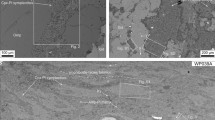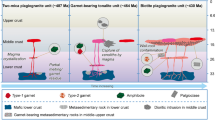Abstract
Bulk chemistry and mineralogy of the peculiar rock of Ricetto (Carseolani Mts., Central Apennines, Italy) was studied to resolve its controversial origin: igneous dyke or anthropic product. This hybrid rock consists of a colorless, felsic component made up of glass plus quartz, and a brown, femic component made up of fans and spherulites of diopside, calcic plagioclase, wollastonite, and melilite. Textural relationships indicate very rapid cooling and immiscibility phenomena. The bulk chemistry of the rock is the same as that of the surrounding siliciclastic sandstone. The 14C analysis of a coal fragment from bottom of the body yields the conventional age of 227(±50) years. The Ricetto occurrence is an example of pyrometamorphism of a siliceous limestone induced by a charcoal pit burning. The small size of the heat source at Ricetto caused an intense but short-lived melting of the country rock. Prograde metamorphism caused a temperature increase up to 1,000–1,100 °C when melilite crystallization conditions were reached at appreciable P(CO2) and high f(O2). Melting occurred in a close system represented by the simplified equation: 3Cal+16.5Qtz+Ms+Bt→Mel+Melt+2H2O+3CO2+0.5O2. Diopside+calcic plagioclase+wollastonite formed by melilite breakdown during rapid cooling, through the reaction: 6Mel+6Qtz+0.5O2→3Di+2An+7Wo. Liquid immiscibility caused the separation between the felsic melt component and the femic melilite-bearing component. Immiscibility was characterized by different fractionation of alumina and alkalies between these two phases. Differences in bulk, glass, and mineral chemistry between the Ricetto and other melilite-bearing pyrometamorphic rocks can be attributed mainly to different protoliths.








Similar content being viewed by others
References
Accordi G, Carbone F, Civitelli G, Corda L, De Rita D, Esu D, Funiciello R, Kotsakis T, Mariotti G, Sposato A (1986) Lithofacies map of Latium-Abruzzi and neighbouring areas. CNR Progetto Finalizzato Geodinamica, sottoprogetto 4
Aurisicchio C, Federico M, Gianfagna A (1988) Clinopyroxene chemistry of the high-potassium suite from the Alban Hills, Italy. Mineral Petrol 39:1–19
Barton M, Varekamp JC, Van Bergen MJ (1984): Complex zoning of clinopyroxenes in the lavas of Vulsini, Latium, Italy: evidence for magma mixing. J Volcanol Geotherm Res 14:361–388
Bastin ES (1905) Note on baked clays and natural slags in eastern Wyoming. J Geol 13:408–412
Bellotti P, Evangelista S, Milli S, Valeri P (1987) Un corpo lavico nelle Marne ad Orbulina di Ricetto. Rend Soc Geol Ital 10:67–70
Bellotti P, Landini B, Valeri P (1984) Associazioni di facies e lineamenti evolutivi generali del “complesso torbiditico altomiocenico laziale-abruzzese”. Bol Soc Geol Ital 103:311–326
Bentor YK (1982) Combustion-metamorphic glasses. J Non-Cryst Solids 67:433–448
Bindeman IN, Bailey JC (1994) A model of reverse differentiation at Dikii Greben’ Volcano, Kamchatka: progressive basic magma vesiculation in a silicic magma chamber. Contrib Mineral Petrol 117:263–278
Bustin RM, Mathews WH (1982) In situ gasification of coal, a natural example: history, petrology, and mechanics of combustion. Can J Earth Sci 19:514–523
Carbonin S, Dal Negro A, Molin GM, Munno R, Rossi G, Lirer L, Piccirillo EM (1984) Crystal chemistry of Ca-rich pyroxenes from undersaturated to oversaturated trachitic rocks, and their relationships with pyroxenes from basalts. Lithos 17:191–202
Cipollari P, Cosentino D, Guerrera F, Laurenzi MA, Renzulli A, Tramontana M (1998) Biostratigraphical correlation and geochronology of volcaniclastic horizons across the Tortonian/Messinian boundary in the Apennine foreland basin system. An Tectonicae 13:113–132
Clark BH, Peacor DR (1992) Pyrometamorphism and partial melting of shales during combustion metamorphism: mineralogical, textural, and chemical effects. Contrib Mineral Petrol 112:558–568
Compagnoni B, Galluzzo F, Pampaloni ML, Pichezzi RM, Raffi I, Rossi M, Santantonio M (1991a) Dati sulla lito-biostratigrafia delle successioni terrigene nell’area tra i Monti Simbruini e i Monti Carseolani (Appennino Centrale). Studi Geol Camerti, vol spec 1991/2:173–179
Compagnoni B, Galluzzo F, Santantonio M (1991b) Schema tettonico dei rilievi carbonatici compresi nel F˚ 367 “Tagliacozzo” alla scala 1:50.000. Studi Geol Camerti, vol spec 1991/2:43–46
Cosca MA, Essene EJ, Geissman JW, Simmons WB, Coates DA (1989) Pyrometamorphic rocks associated with naturally burned coal beds, Powder River Basin, Wyoming. Am Mineral 74:85–100
Cundari A, Ferguson AK (1991) Petrogenetic relationships between melilite and lamproite in the Roman Comagmatic Region: the lavas of S. Venanzo and Cupaello. Contrib Mineral Petrol 107:343–357
De Wys EC, Foster WR (1958) The system diopside – anorthite - åkermanite. Mineral Mag 31:736–743
Eskola P (1939) Die metamorphen Gesteine. In: Barth TFW, Correns CW, Eskola P (eds) Die Entstehung der Gesteine. Springer, Berlin Heidelberg New York, pp 263–407
Ferry JM, Wing BA, Penniston-Dorland SC, Rumble D (2002) The direction of fluid flow during contact metamorphism of siliceous carbonate rocks: new data from the Monzoni and Predazzo aureoles, northern Italy, and global review. Contrib Mineral Petrol 142:679–699
Fine G, Stolper E (1985) Dissolved carbon dioxide in basaltic glasses: concentrations and speciation. Earth Planet Sci Lett 76:263–278
Fine G, Stolper E (1986) The speciation of carbon dioxide in sodium aluminosilicate glasses. Contrib Mineral Petrol 91:105–121
Foit FF, Hooper RL, Rosenberg PE (1987) An unusual pyroxene, melilite, and iron oxide mineral assemblage in a coal-fire buchite from Buffalo, Wyoming. Am Mineral 72:137–147
Freestone IC, Powell R (1983) The low-temperature field of liquid immiscibility in the system K2O–Al2O3–FeO–SiO2 with special reference to the join fayalite–leucite–silica. Contrib Mineral Petrol 82:291–299
Fuhrman ML, Lindsley DH (1988) Ternary-feldspar modeling and thermometry. Am Mineral 73:201–215
Gallo F, Giammetti F, Venturelli G, Vernia L (1984) The kamafugitic rocks of San Venanzo and Cuppaello, Central Italy. Neues Jahrb Mineral Mh 5:198–210
Giordano G (1981) Tecnologia del legno. UTET, Torino, pp 995–1014
Heinrich W, Gottschalk M (1994) Fluid flow patterns and infiltration isograds in melilite marbles from the Bufa del Diente contact metamorphic aureole, north-east Mexico. J Metamorph Geol 12:345–359
Hoscheck G (1974) Gehlenite stability in the system CaO–Al2O3–SiO2–H2O–CO2. Contrib Mineral Petrol 47:245–254
Ihinger PD, Hervig RL, McMillan PF (1994) Analytical methods for volatiles in glasses. Rev Mineral 30:67–121
Koch L (1930) Über das System Wollastonit – Anorthit – Pyroxen. Neues Jahrb Mineral Geol Beilage Bd 61:278–318
Lange J, Carmichael ISE (1987) Densities of Na2O–K2O–CaO–MgO–FeO–Fe2O3–Al2O3–TiO2–SiO2 liquids: new measurements and derived partial molar properties. Geochim Cosmochim Acta 53:2195–2204
Lange J, Carmichael ISE (1990) Thermodynamic properties of silicate liquids with emphasis on density, thermal expansion and compressibility. Rev Mineral 24:25–64
Lupini L (1993) Il distretto ultalcalino umbro-laziale: mineralogia, petrologia, geochimica e relazioni con il contesto tettonico. PhD Thesis, Univ Perugia, 422 pp
Naslund HR (1983) The effect of oxygen fugacity on liquid immiscibility in iron-bearing silicate melts. Am J Sci 283:1034–1059
Osborn EF, Schairer JF (1941) The ternary system pseudowollastonite–åkermanite–gehlenite. Am J Sci 239:715–763
Papike JJ, Cameron KL, Baldwin K (1974) Amphiboles and pyroxenes: characterization of other than quadrilateral components and estimates of ferric iron from microprobe data. Geol Soc Am Progr Abstr 6:1053–1054
Pawley AR, Holloway JR, McMillan PF (1992) The effect of oxygen fugacity on the solubility of carbon-oxygen fluids in basaltic melt. Earth Planet Sci Lett 110:213–225
Philpotts AR (1976) Silicate liquid immiscibility: its probable extent and petrogenetic significance. Am J Sci 276:1147–1177
Philpotts AR (1977) Archean variolites—quenched immiscible liquids: discussion. Can J Earth Sci 14:139–144
Philpotts AR (1982) Composition of immiscible liquids in volcanic rocks. Contrib Mineral Petrol 80:201–218
Roedder E (1951) Low-temperature liquid immiscibility in the system K2O–FeO–Al2O3–SiO2. Am Mineral 36:282–286
Schölze H (1959) Der Einbau der Wassers in Gläsern. Glastech Ber 32:81–88
Stolper E (1982) Water in silicate glasses: an infrared spectroscopic study. Contrib Mineral Petrol 81:1–17
Stoppa F (1988) L’euremite di Colle Fabbri (Spoleto): un litotipo ad affinità carbonatica in Italia. Bol Soc Geol Ital 107:239–248
Traversa G, Bellotti P, Evangelista S, Milli S, Ronca S, Traversa F, Valeri P (1991) Preliminary data on melilititic lavas of the Carseolani Mountains (Rieti). Per Mineral 60:81–82
Treiman AH, Essene EJ (1983) Phase equilibria in the system CaO–SiO2–CO2. Am J Sci 283A:97–120
Velde D, Yoder HS Jr (1977) Melilite and melilite-bearing igneous rocks. Carnegie Inst Wash Annu Rep Dir Geophys Lab 1976–7:478–485
Visser W, Koster van Groos AF (1979) Phase relationship in the system K2O–FeO–Al2O3–SiO2 with special emphasis on low-temperature immiscibility. Am J Sci 274:70–91
Weiblen PW, Morey GB (1980) A summary of the stratigraphy, petrology, and stricture of the Duluth Complex. Am J Sci 280A:88–133
Williams JP, Su Y-S, Strzegowski WR, Butler BL, Hoover HL, Altemose VO (1976) Direct determination of water in glass. Ceram Bull 55:524–527
Yoder HS (1952) The MgO–Al2O3–SiO2–H2O system and the related metamorphic facies. Am J Sci, Bowen vol, pp 569–627
Yoder HS (1973) Melilite stability and paragenesis. Fortschr Mineral 50:140–173
Zharikov VA, Shmulovich KI, Bulatov VK (1977) Experimental studies in the system CaO–MgO–Al2O3–SiO2–CO2–H2O and conditions of high-temperature metamorphism. Tectonophysics 43:142–162
Acknowledgements
D. Cosentino (Rome) challenged us to clarify the origin of the Ricetto body. M. Follieri (Rome) gave us encouragement and helpful suggestions. Revisions by A. Mottana (Rome) enabled us to improve both the contents and style of the manuscript. This paper also benefited by revisions and criticism of M. Raith (Bonn) and T. Kunzmann (Munich), which are gratefully acknowledged. G.M. Crisci (Cosenza) and C. Aurisicchio (Rome) provided the XRF and EMP analysis facilities, respectively. Assistance of U. Lanzafame (XRF), L. Martarelli (EMPA), P. Cipollari (SEM), and C. Romano (FTIR) is also acknowledged. Courtesy of R. Marcon (IGI) has been invaluable. During the final revision phase of this manuscript, one of the authors, Salvatore Improta, passed away unexpectedly. Still stunned, the other authors can only mourn for the loss of a such careful scientist and amiable person.
Author information
Authors and Affiliations
Corresponding author
Additional information
An erratum to this article can be found at http://dx.doi.org/10.1007/s00531-004-0399-2
Rights and permissions
About this article
Cite this article
Capitanio, F., Larocca, F. & Improta, S. High-temperature rapid pyrometamorphism induced by a charcoal pit burning: The case of Ricetto, central Italy. Int J Earth Sci (Geol Rundsch) 93, 107–118 (2004). https://doi.org/10.1007/s00531-003-0374-3
Received:
Accepted:
Published:
Issue Date:
DOI: https://doi.org/10.1007/s00531-003-0374-3




